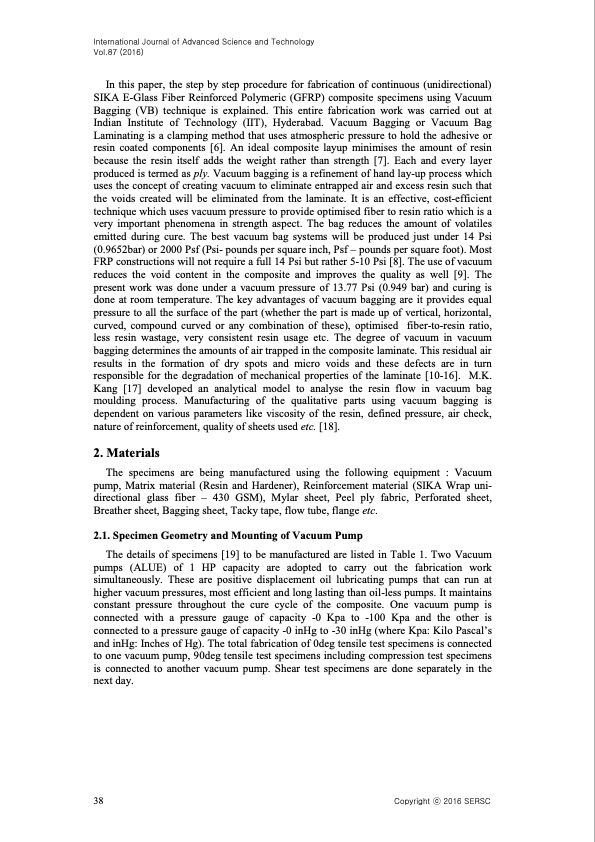
PDF Publication Title:
Text from PDF Page: 002
International Journal of Advanced Science and Technology Vol.87 (2016) In this paper, the step by step procedure for fabrication of continuous (unidirectional) SIKA E-Glass Fiber Reinforced Polymeric (GFRP) composite specimens using Vacuum Bagging (VB) technique is explained. This entire fabrication work was carried out at Indian Institute of Technology (IIT), Hyderabad. Vacuum Bagging or Vacuum Bag Laminating is a clamping method that uses atmospheric pressure to hold the adhesive or resin coated components [6]. An ideal composite layup minimises the amount of resin because the resin itself adds the weight rather than strength [7]. Each and every layer produced is termed as ply. Vacuum bagging is a refinement of hand lay-up process which uses the concept of creating vacuum to eliminate entrapped air and excess resin such that the voids created will be eliminated from the laminate. It is an effective, cost-efficient technique which uses vacuum pressure to provide optimised fiber to resin ratio which is a very important phenomena in strength aspect. The bag reduces the amount of volatiles emitted during cure. The best vacuum bag systems will be produced just under 14 Psi (0.9652bar) or 2000 Psf (Psi- pounds per square inch, Psf – pounds per square foot). Most FRP constructions will not require a full 14 Psi but rather 5-10 Psi [8]. The use of vacuum reduces the void content in the composite and improves the quality as well [9]. The present work was done under a vacuum pressure of 13.77 Psi (0.949 bar) and curing is done at room temperature. The key advantages of vacuum bagging are it provides equal pressure to all the surface of the part (whether the part is made up of vertical, horizontal, curved, compound curved or any combination of these), optimised fiber-to-resin ratio, less resin wastage, very consistent resin usage etc. The degree of vacuum in vacuum bagging determines the amounts of air trapped in the composite laminate. This residual air results in the formation of dry spots and micro voids and these defects are in turn responsible for the degradation of mechanical properties of the laminate [10-16]. M.K. Kang [17] developed an analytical model to analyse the resin flow in vacuum bag moulding process. Manufacturing of the qualitative parts using vacuum bagging is dependent on various parameters like viscosity of the resin, defined pressure, air check, nature of reinforcement, quality of sheets used etc. [18]. 2. Materials The specimens are being manufactured using the following equipment : Vacuum pump, Matrix material (Resin and Hardener), Reinforcement material (SIKA Wrap uni- directional glass fiber – 430 GSM), Mylar sheet, Peel ply fabric, Perforated sheet, Breather sheet, Bagging sheet, Tacky tape, flow tube, flange etc. 2.1. Specimen Geometry and Mounting of Vacuum Pump The details of specimens [19] to be manufactured are listed in Table 1. Two Vacuum pumps (ALUE) of 1 HP capacity are adopted to carry out the fabrication work simultaneously. These are positive displacement oil lubricating pumps that can run at higher vacuum pressures, most efficient and long lasting than oil-less pumps. It maintains constant pressure throughout the cure cycle of the composite. One vacuum pump is connected with a pressure gauge of capacity -0 Kpa to -100 Kpa and the other is connected to a pressure gauge of capacity -0 inHg to -30 inHg (where Kpa: Kilo Pascal’s and inHg: Inches of Hg). The total fabrication of 0deg tensile test specimens is connected to one vacuum pump, 90deg tensile test specimens including compression test specimens is connected to another vacuum pump. Shear test specimens are done separately in the next day. 38 Copyright c 2016 SERSCPDF Image | Fabrication of Continuous GFRP Composites using Vacuum Bag

PDF Search Title:
Fabrication of Continuous GFRP Composites using Vacuum BagOriginal File Name Searched:
GFRP-Composites-using-Vacuum-Bag.pdfDIY PDF Search: Google It | Yahoo | Bing
5,000 BF Shipping Container Lumber Dry Kiln For Quality Lumber The 5,000 BF container kiln consists of one 40 foot high-cube aluminum shipping container... More Info
Shipping Container Lumber Dry Kilns by Global Energy Global Energy designed and developed the container kiln back in 1991. The purpose is to give access to portable sawmill owners, furniture makers, and small business the value added profit of dry kiln lumber and quality hardwoods... More Info
Vacuum Kiln Conversion Kit for Lumber and Wood Dry Kilns Convert your existing conventional dry kiln into a fast drying vacuum kiln. Similar to vacuum bagging in the boat building and aircraft industry, we have come up with a proprietary process which allows you to build a very simple vacuum kiln at a fraction of the price, and without the intensive conventional metal chamber structure... More Info
Vacuum Pump Cart System for Bagging Clamping Wood Drying and more Vacuum Cart with 2HP Pump and Dual Pistons with multiple multiplex vacuum ports and liquid reservoir... More Info
Vacuum Bagging Basics Vacuum bagging is a method of clamping, which has traditionally been used in the composites industry, but can also be used for vacuum drying materials, including wood products... More Info
| CONTACT TEL: 608-238-6001 Email: greg@globalmicroturbine.com | RSS | AMP |